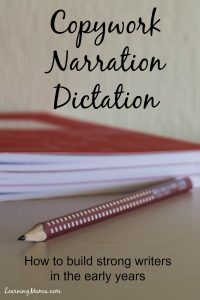Despite the plethora of book reports, journals, poetry, short stories, and writing prompts being used in schools, students continue to be unprepared for skilled writing in high school and college. We hear this lament from college professors over and over again — we are turning out a generation of students with subpar writing skills.
A popular strategy to teaching writing seems to be pushing for an increase in volume of writing, and not on quality. The theory that such teachers hold is that the younger a child writes, the more they write, the better writers they will become. All the while we keep hearing “my child hates writing!” and our high schools, colleges, and workplaces (and Facebook newsfeeds, ahem!) are filled with terrible writers.
This post contains affiliate links. Please see my discloser policy for details.
I am by no means an excellent writer. I have had no particular education, training, or experience in writing other than the self education I am receiving as I educate my own children at home. Yet I am convinced that the three simple tools espoused by classical education are the best way to build strong writers in the early years.
We’ve already examined the first two tools, copywork and narration, and today we’re exploring the third, dictation.
What is dictation?
Dictation is simply the writing down of a word, phrase, sentence, or passage spoken. The teacher recites the dictation exercise, and the student transcribes.
What are the benefits of dictation?
Dictation, like copywork and narration, has many benefits for young writers. The most significant however, is the role that it plays in building the skill of holding words in the mind long enough to get them onto paper. Sara Buffington & Jessie Wise, authors of First Language Lessons, write:
Dictation teaches the student to picture a sentence in his mind before putting it down on paper and also trains him to hold complete sentences in his memory as he writes. Dictation prepares the student for original writing, since it allows the young writer to practice mechanics without also struggling to produce original content
Besides “picturing a sentence in the mind”, there are also these benefits to dictation:
- It provides practice for spelling, punctuation, capitalization, and proper sentence structure
- It teaches spelling in context, or in “real life” application
- It trains the attention span, concentration, and listening skills.
- It develops a great skill for use in many areas later in life — as a waiter remembering & transcribing orders, for note taking in higher education, and more!
How to Use Dictation in your Homeschool
The basic process for a dictation exercise is quite simple:
- Dictate, or read a passage to the student. Repeat if passage is long or it is otherwise necessary.
- Child repeats the passage from memory.
- Child transcribes the passage.
Dictation Tips:
- Start with short, simple passages. Increase the complexity and length of the dictation gradually.
- Choose quality passages, from children’s classics for example.
- Use passages that contain only words they have previously learned to spell, or provide the student with a list of difficult words.
- Introduce only one new punctuation element at a time; progressing from periods, comas, and exclamation points on to the more difficult colons, semi-colons, etc.
- Remind the student to read through their completed dictation and check their spelling and punctuation. Reading it aloud is often more helpful than silently.
- Allow the student to compare their writing to the model and correct their work. Discovering their own errors will add to the exercise by helping them identify errors in their other writings.
This is a helpful video of Susan Wise Bauer doing a dictation exercise from Writing With Ease Level 4 with her son. Its a great example of how to manage the increasing complexity of dictation passages with your students as their skills progress — and it shows how to provide extra help by giving the student a head’s up about the particulars of the punctuation involved. The amount of distraction present during the exercise however, would NOT work at all for my students (or me)! The video is in two parts, so if you want to see more, click through to YouTube and watch Part Two.
Dictation seems so simple, but along with copywork and narration, it lays the foundation for quality, original writing in later years. Take the time in the beginning to master these essential skills for building strong writers!
Don’t miss the first three posts in this series on early writing:
- Building Strong Writers in the Early Years
- Copywork: The Power of Learning through Imitation
- Narration: The Art of Oral Composition






Hello!
When is a good time to start dictation? We have been doing easy copy work and narration with my first grader already. And our All About Spelling uses dictation for vocabulary words, but I’m not sure that “counts.”
Maybe around second grade? It’s going to vary greatly from child to child. Start with super short sentences with words they are confident spelling, and build from there.